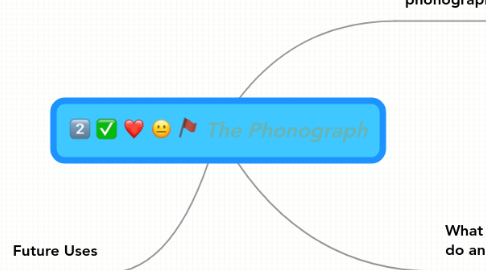
1. Future Uses
1.1. There were many future uses that Edison expected of his new invention.
1.1.1. Letter writing and all kinds of dictation without the aid of a stenographer.
1.1.2. Phonoraphic books, which will speak to blind people without effort on their part.
1.1.3. Reproduction of music
1.1.4. Clocks that should nnounce in a articulate speach the time for going hom ect.
1.1.5. The phonograph has provided musical recordings spanning various genres of music but, for the masses, it recorded and played back the messages of politicians, intellectuals, and social leaders.
2. Who invented the phonograph?
2.1. Thomas Edison originally invented the phonograph.
2.1.1. Thomas also invented the lightbulb, film projectors, and motion pictures.
2.1.2. Later, Alexander Bell, chemical enginer, and Charles Tainter, science and instrument maker, improved the phonograph.
2.1.2.1. Alexander Bell developed a method of making phonograph records on a wax disc.
3. What does the phonograph do and how does it work?
3.1. How does it work?
3.1.1. When you speak into the mouthpiece the sound vibrations make a groove pattern in the wax.
3.2. What does it do?
3.2.1. The phonograph is a mix of the telegraph and the telephone.
